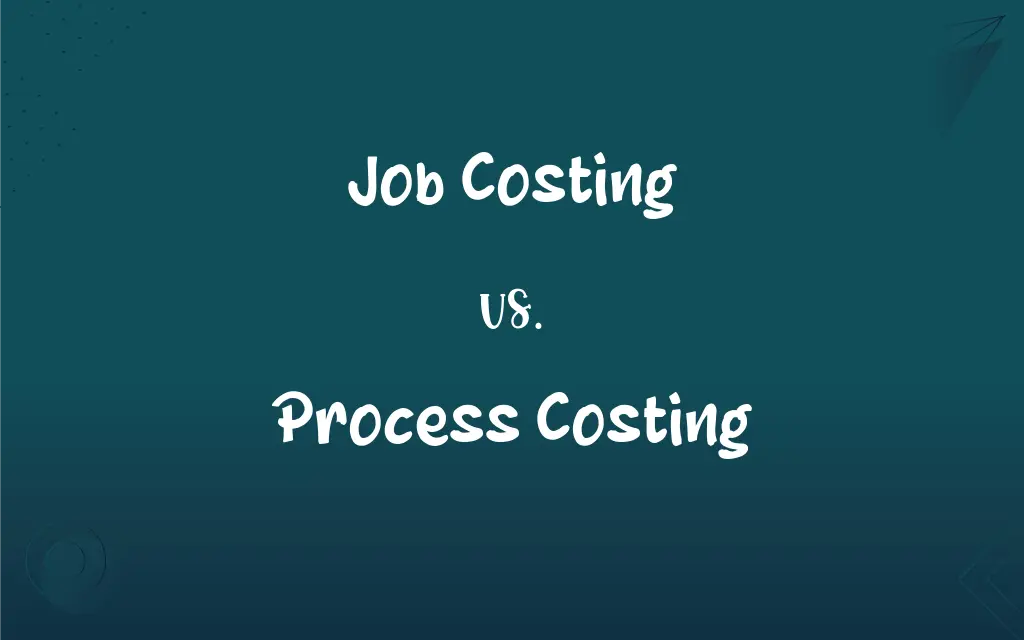Job Costing vs. Process Costing: What's the Difference?
Edited by Aimie Carlson || By Harlon Moss || Updated on October 26, 2023
Job costing allocates costs for individual, custom projects, while process costing distributes costs across numerous identical units.

Key Differences
Job costing and process costing are two vital cost accounting methods businesses use to evaluate expenses. Job costing is tailored to individualized, custom tasks or projects, assigning direct and indirect costs to a specific job. Conversely, process costing suits environments where similar products are mass-produced, dividing costs evenly across all units.
The application varies for both job costing and process costing. Industries such as construction, film production, or bespoke furniture making often prefer job costing since every project is unique with distinct requirements. In contrast, industries like oil refining, cereal production, or any sector with a continuous production line, tend to employ process costing, given the standardized nature of their output.
Job costing offers granularity. By focusing on individual jobs, companies can closely monitor the expenses and profitability of each specific task or project. This provides detailed insights into which jobs are more lucrative or which ones might be causing financial drains. Meanwhile, process costing aggregates costs, spreading them across multiple units. This broad-brush approach simplifies the cost analysis for industries churning out large volumes of identical products.
The flexibility of job costing allows companies to adapt pricing, resources, or strategies for each unique job, ensuring profitability and customer satisfaction. On the other hand, process costing emphasizes efficiency and economies of scale. By understanding the cost for each production process, companies can identify areas of improvement, streamlining production to achieve optimal results.
While job costing and process costing might seem worlds apart, both aim for the same goal: understanding costs to enhance profitability. Choosing between them depends entirely on the nature of the product or service being offered, the industry's demands, and the company's specific operational structure.
ADVERTISEMENT
Comparison Chart
Nature of Product/Service
Unique, custom products or services
Mass-produced, standardized products
Application
Construction, film production, bespoke products
Oil refining, cereal production, continuous production lines
Cost Allocation
Directly to individual jobs
Evenly distributed across all units
Precision
Detailed, specific to each project
Broad, aggregated for numerous products
Pricing Flexibility
Can adapt pricing per job
Pricing usually standardized due to consistent costs
ADVERTISEMENT
Job Costing and Process Costing Definitions
Job Costing
Costing suited for industries with varied projects.
Film producers rely heavily on job costing to budget movies.
Process Costing
Evaluating costs at different stages of production.
The textile mill used process costing to monitor expenses at every phase of fabric creation.
Job Costing
Assigning costs to specific, custom jobs.
Through job costing, the advertising agency priced each campaign differently.
Process Costing
Suited for mass-produced, standardized products.
Process costing was integral for the soda company to maintain consistent pricing.
Job Costing
Evaluating direct and indirect costs per job.
By using job costing, the event planner knew exactly how much to charge for each event.
Process Costing
Aggregating costs for large volumes of similar products.
Due to the vast production of chips, the factory relied on process costing for simplicity.
Job Costing
A detailed approach to understanding the expenses of unique tasks.
Job costing helped the bespoke furniture maker price each piece appropriately.
Process Costing
A costing method for continuous production processes.
The cereal manufacturer employed process costing to price each box uniformly.
Job Costing
A costing method for individual projects or tasks.
Using job costing, the construction company determined the profitability of building each house.
Process Costing
Distributing costs evenly over multiple identical units.
With process costing, the refinery understood the expense of processing each barrel of oil.
FAQs
Which method offers more detailed insights into costs?
Job costing, as it drills down into the expenses of each specific project or task.
Which industries typically use job costing?
Construction, film production, bespoke manufacturing, and advertising agencies often employ job costing.
Can a company use both job costing and process costing?
Yes, some companies might use job costing for custom projects and process costing for standardized products.
Is job costing suitable for mass production?
Generally, no. Job costing is best for unique, custom tasks, whereas process costing suits mass production.
How does process costing handle indirect costs?
Process costing distributes indirect costs evenly across all produced units.
In which industries is process costing prevalent?
Industries like oil refining, food production, and any sector with continuous production lines typically use process costing.
How do companies decide between job costing and process costing?
The decision is typically based on the nature of the product or service and the industry's demands.
How does job costing ensure profitability?
By understanding costs at the individual project level, companies can adapt pricing and resources accordingly.
Can job costing adapt to varied customer requirements?
Absolutely, job costing's flexibility allows for adaptations per the unique needs of each job.
Is process costing suitable for service industries?
It can be, especially if the services provided are standardized and repetitively performed.
Is process costing simpler than job costing?
Often, yes, since process costing aggregates costs over many identical products, simplifying the analysis.
Can process costing help in reducing production inefficiencies?
Yes, by identifying cost bottlenecks in the production process, companies can streamline operations.
Are there any hybrids of job and process costing?
Yes, some industries might employ a mix, especially if they have both custom and standardized offerings.
Do companies using process costing produce only one product?
Not necessarily. They may produce various products, but the products within a category are usually identical.
How does job costing affect pricing strategies?
Since costs are known at the job level, pricing can be adjusted per project to ensure profitability.
Is process costing static, or can it evolve?
Like all methods, it can evolve, especially as production techniques and products change over time.
How does job costing handle overhead costs?
Overhead costs are allocated based on predetermined rates specific to each job or project.
Which method gives a broader view of costs?
Process costing, as it provides a more aggregated view over numerous products.
Is job costing labor-intensive?
It can be, given the need to assign costs to individual projects, requiring detailed tracking.
What's the primary aim of process costing?
To understand and optimize costs across standardized production processes, emphasizing efficiency.
About Author
Written by
Harlon MossHarlon is a seasoned quality moderator and accomplished content writer for Difference Wiki. An alumnus of the prestigious University of California, he earned his degree in Computer Science. Leveraging his academic background, Harlon brings a meticulous and informed perspective to his work, ensuring content accuracy and excellence.
Edited by
Aimie CarlsonAimie Carlson, holding a master's degree in English literature, is a fervent English language enthusiast. She lends her writing talents to Difference Wiki, a prominent website that specializes in comparisons, offering readers insightful analyses that both captivate and inform.
































































